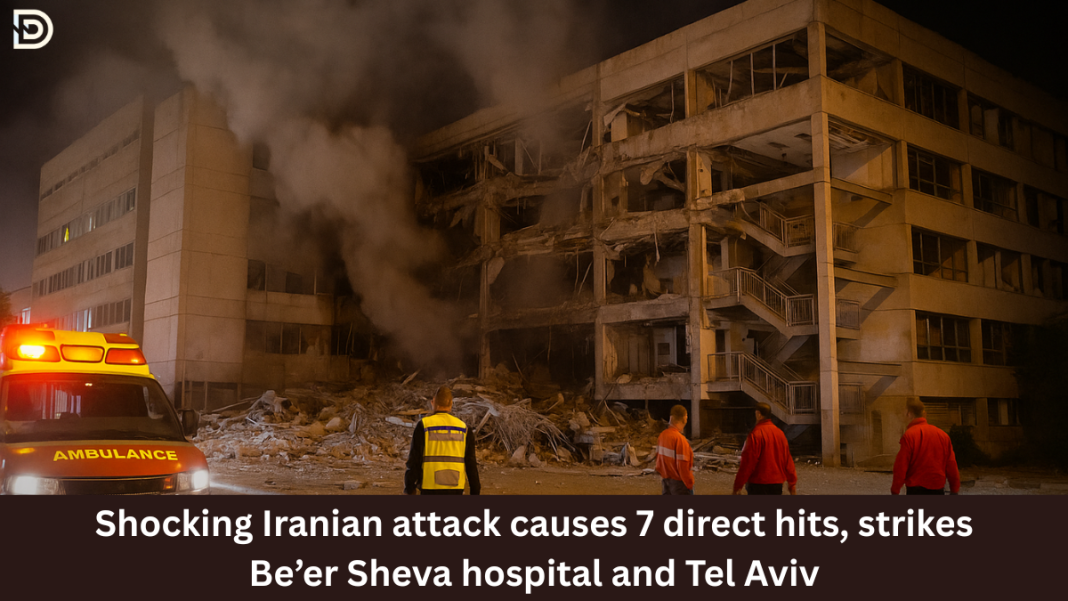A missile attack launched from Iran hit the Soroka Medical Center in Be’er Sheva on Thursday. The strike caused serious damage to the hospital, one of the largest medical centers in southern Israel. Israeli officials verified that the missile was part of a broader series of Iranian attacks targeting various locations.
Direct attack on Be’er Sheva Hospital
Shortly after the attack on the hospital, emergency services and police teams rushed to the scene. Due to fears of a hazardous material leak on an upper floor of the building, authorities began evacuating people as a precaution. However, the danger was later ruled out after inspection.
Medical staff inside the hospital responded quickly following the attack, working to move patients and ensure their safety. While the full extent of the damage is still being assessed, officials have stated that emergency medical operations are continuing in the unaffected areas of the facility.
Multiple Missile Impacts Across Israel
On the same day, a large-scale attack involving missiles and drones from Iran targeted several regions of Israel. According to reports, at least seven different locations in central and southern Israel were hit directly by missiles.
In Tel Aviv, Ramat Gan, and Holon, residents heard loud explosions and saw flashes in the sky as air raid sirens wailed. The missiles caused physical damage to buildings and streets. Emergency services were dispatched quickly. In Holon, three people were seriously injured. Medical teams from Magen David Adom (MDA) provided immediate treatment.
Northern Israel was also hit. Sirens were heard in cities and towns near the borders, and people were told to stay in bomb shelters. The military confirmed that missiles targeted areas near the Lebanese border and the Golan Heights.
🚨 Iran Strikes Israeli Hospital: Soroka Medical Center Hit in Unprecedented Missile Attack
Alerts went out across the country instructing residents to find protected spaces and stay there until given clear instructions to come out. This helped prevent more injuries.
In total, the Israeli military (IDF) stated that Iran launched around 1,000 drones and 400 ballistic missiles. While many were intercepted by Israeli air defense systems, about 100 drones reached Israeli territory. Of the 400 missiles, around 20 landed in populated areas, causing injuries and destruction.
Nationwide Emergency and Military Response to Missile Attack
The IDF immediately began striking back. On Wednesday night, it carried out airstrikes on various targets inside Iran. These included missile launchers, weapons warehouses, and other military sites, especially near Tehran and areas in western Iran.
One of the most significant strikes was on the Arak-Khondab area, where Iran’s heavy water nuclear reactor is located. The IDF said it specifically targeted the reactor’s core seal, a key part of the system used in plutonium production. The goal, according to military sources, was to prevent Iran from using it for nuclear weapons.
The military also sent out warnings in the Persian language, asking civilians near the reactor area to evacuate immediately for their safety.
Iran launched the Sejjil, a long-range ballistic missile, in another incident. It was intercepted in midair and was aimed at central Israel. However, a man in his automobile was hurt by shrapnel from the explosion.
Air Travel, Evacuations Affected as Missile Threat Grows
Israel’s air defense systems were under heavy pressure throughout the night. Sirens sounded in multiple areas, including the Jordan Valley and the northern towns of Argaman, Hamra, Mekhora, and Hemdat. In one case, the IDF successfully intercepted a drone launched from Iran.
The intensity of the attacks also impacted air travel. Two Israeli flights returning home were rerouted to Cyprus due to the security situation. Meanwhile, foreign governments began taking action. France announced plans to help its citizens leave both Israel and Iran. The U.S. Embassy in Jerusalem was ready to use cruise ships and rescue planes to evacuate American citizens.
Back in Israel, the Home Front Command updated safety instructions for the public. Some restrictions were eased slightly in certain areas, allowing small gatherings where shelters were available. However, in many regions of the nation, schools and other educational facilities remained closed.
To support ongoing defense operations, the United States is reportedly sending the USS Ford aircraft carrier closer to the conflict zone. It may soon arrive in the Mediterranean Sea.
The International Atomic Energy Agency (IAEA) also made a troubling announcement. They said they could no longer verify the location of Iran’s enriched uranium, which is close to the level needed for nuclear weapons.
The situation remains tense. Israeli officials have confirmed continued military operations targeting Iran’s military infrastructure, with a focus on stopping future attacks and preventing nuclear advancement.

